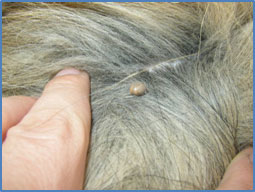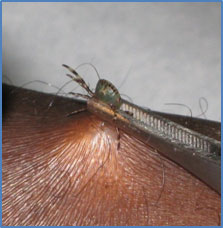Posted by Zena Conkey on Apr 07, 2020

Ticks are a type of external parasite related to mites, spiders and scorpions. These insects are fairly small but they can pose a great threat to your dog. Not only do ticks feed on your dog’s blood, but they can also expose him to a variety of deadly diseases. Female ticks are also known to lay eggs on the host body which then hatch into larvae and eventually grow into adult ticks. If you do not take care to prevent ticks, and if you do not regularly check your dog for these parasites, your dog could end up suffering from a tick infestation. To ensure that your dog stays healthy and tick-free, take the time to learn how your dog might be exposed to ticks and the dangers they pose to his health.

Types of Ticks
Though there are many different types of ticks, only a few kinds typically affect dogs in the UK. One of the ticks that commonly affects dogs in the UK is the sheep tick (Ixodes ricinus). These ticks are also known as deer ticks and they can infest humans as well as dogs and other animals. The hedgehog tick (Ixodes hexagonus) is another species of tick known to infest dogs, as is the British dog tick (Ixodes canisuga). Though less common in the UK, the brown dog tick (Rhipecephalus sanguineus) and the American dog tick (Demacentor variabilis) can also pose a threat. The population of these various species of ticks may vary by geographic location but dogs in the UK are most likely to be exposed to ticks in areas of woodland, heathland and moorland.

Effects of Ticks on Dogs
Ticks do not differentiate between dogs of different size, breed or age – they are opportunistic parasites, ready to clamp on to any warm-blooded animal that passes by. Shortly after arriving on the host body, ticks will bite the host and begin feeding on its blood. During the feeding process, the tick’s saliva may mingle with the dog’s blood and thus enter his bloodstream – this is how disease is typically transmitted by ticks. Though they often climb onto dogs via the legs, ticks typically settle in the areas around a dog’s ears, under his armpits and between the toes. While some dogs have little physical response to tick bites, others develop visible signs of irritation and even serious allergic reactions. The most common reactions to tick bites include redness and inflammation at the site of the bite which causes the dog to scratch, lick and bite at the area. In cases of severe infestation and allergic reactions, dogs may become anemic due to blood loss
Diseases Transmitted by Ticks
In addition to the potential for allergic reactions, ticks may also carry a variety of diseases that can impact your dog’s health. Sheep ticks, for example, are carriers of borreliosis, or Lyme disease, which can cause fever, arthritis and neurological damage in dogs. These ticks may also carry Anaplasmosis, an infectious blood disease that affects the immune system, causing fever, seizures, meningitis, joint swelling and even lameness. Though Lyme disease and Anaplasmosis are endemic in the UK, dogs travelling to abroad may be exposed to different disease-carrying ticks in North America. The American dog tick, for example, has been known to carry Ripicephalus ricketsii, the vector responsible for Rocky Mountain fever and tick paralysis. Rocky Mountain fever can cause serious inflammation and tissue damage as well as the necrosis, or death, of blood vessels. In addition to these deadly diseases, ticks can also carry tularemia, ehrlichiosis and babesiosis.
How to Remove a Tick

If when grooming or petting your dog you come across a tick embedded in his skin, it is important that you take action immediately to remove it. The longer a tick stays attached to your dog’s skin, the more saliva it will release, increasing the chances that your dog will be exposed to harmful bacteria or disease. When removing a tick, it is essential that you do not squeeze the body of the tick because this could result in the tick depositing more saliva in the wound. To remove a tick safely, use a pair of tweezers to grab the tick by the head right where it is attached to the skin. Using a firm, steady motion pull the tick away from your dog’s body without squeezing it. To kill the tick, deposit it in a jar of alcohol.
For dogs that spend a great deal of time outdoors in areas where ticks are known to be present, it may be worth it to invest in an O’Tom Tick Twister. This device is specially designed to remove embedded ticks without squeezing the abdomen or leaving the mouth parts behind in your dog’s skin. The O’Tom Tick Twister even comes with an assortment of hooks to accommodate ticks of various sizes. To use the O’Tom Tick Twister, simply slip the hook around the embedded tick from the side and, as you lift the hook away from your dog’s body, gently turn it to detach the tick.
Tips for Preventing Ticks

When it comes to preventing ticks on your dog, you have a number of options. After taking your dog outside, it is wise to check his fur and skin for ticks so you can catch them before they become embedded. Brushing and combing your dog’s coat regularly will also give you a chance to check for ticks. If you want to prevent a tick infestation, consider purchasing a flea and tick collar or treat your dog with a topical flea and tick preventive. Many topical tick preventives come with easy-to-use applicators and they need only be applied once a month. In addition to collars and topical preventives, you can also find shampoos such as the Tropiclean Flea-Tick shampoo range designed to remove and prevent ticks on dogs.
Because ticks can have such a negative impact on your dog’s health it is important that you do all you can to prevent them. No matter how hard you try to protect him, however, your dog is likely to be exposed to ticks at some point and how you respond to this situation will play a role in determining the effect on your dog. If you regularly examine your dog’s skin for ticks and remove them as soon as you find them, you can greatly decrease your dog’s chances of being exposed to tick-borne diseases.
The above product and more can be found on the
Dog Grooming and Health section of the K9active website
